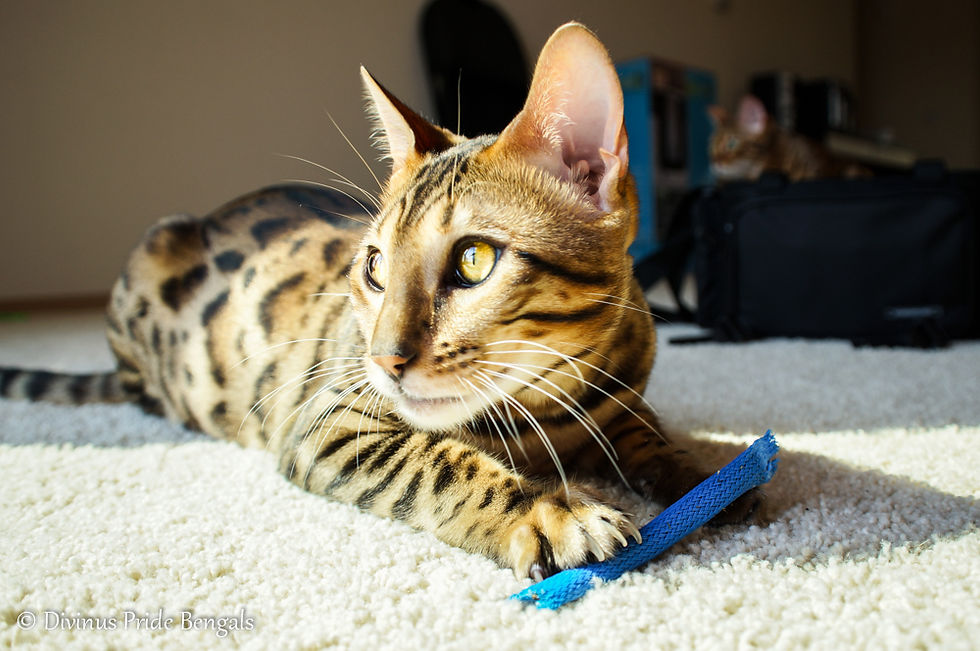Bengal Cat Glitter Gene
- Divinus Pride Bengals
- Dec 15, 2023
- 4 min read
Updated: Dec 23, 2023

As more people have learned about Bengals and desire one, the need for genetic research has increased. Not only do these studies increase information about the desired appearance of the Bengal cat, such as the glitter gene, but they help keep the Bengal breed healthy, by preventing the spread of genetic disorders.
Screening for Genetic Disorders: Polycystic Kidney Disease (PKD), Progressive Retinal Atrophy (PRA), Hypertrophic Cardiomyopathy (HCM) and Pyruvate Kinase Deficiency are the most common diseases to which Bengals can be susceptible. In future blog posts, these disorders will be discussed in great detail.
Bengal Genetics: The Magic Behind the Bengal Cat Glitter Gene
If you're a cat lover, you're probably aware of the Bengal cat’s beautiful appearance. This breed is known for its wild-like markings and athletic physique. However, did you know about the Bengal cat's glitter gene? This fascinating genetic trait may be the most enchanting aspect of these gorgeous cats. In this post, you'll learn everything you need to know about the Bengal cat's glitter gene, including how it adds a touch of magic to your favorite feline friend.
Unscrambling the Secrecy of the Glitter
The glitter gene in Bengal cats presents itself as a shimmering, holographic sheen on the surface of their fur. It appears to sparkle under certain lights, making for a spectacular sight to behold. The shimmering effect produced by the glitter gene is also known as "glittering" or "glitter dust." Here are a few important points about the gene:
Glitter was at first thought to be a recessive gene, meaning that both parents must carry the gene for the offspring to inherit it. More recently it is thought to be an accumulative gene. This means if you breed two kittens then the offspring will have even more glitter than Mom and Dad! This process can be continued with each generation being more and more glittered.
Not all Bengal cats possess the glitter gene.
The glitter gene is currently exclusive to Bengal cats, although breeders are studying the possibilities of introducing it to other breeds.
The overall health or temperament of the cat is not affected by the gene.

The Glitter Gene: A Three Dimensional Twist to Your Bengal Buddy
You may be wondering how such a unique trait occurs. Here's the science:
The glitter gene affects the medulla of the hair shaft
The medulla reflects and refracts light, creating the appearance of shimmering, glitter-like highlights
The glitter effect is found in many different colors and patterns of Bengal cats
Why Bengal Cats with Glitter Are So Desirable
The sight of a Bengal cat glistening like a diamond is a feast for the eyes. However, there are other reasons to admire these glittered felines:
The glitter gene sets Bengal cats apart as unique and rare
The glittering effect adds depth and dimension to the coat pattern
Bengal cats with this gene have a softer, silkier coat texture
It emphasizes the regal and wild appearance of the breed
Types of Glitter in Bengals
Two different types of glitter can be found on Bengal cats: mica and satin.
Mica only affects the tips of the hairs. This produces a reflective effect.
Satin affects the whole hair shaft. This gives the coat a pearl-like effect also known as “oyster.” Satin hair shafts contain many pockets of air along their length. These air pockets refract light and give the coat a smooth, soft silkiness. The satin type of glitter can also become elongated, which makes the fur even softer and silkier.
Any color may be glittered. Since the gene is a recessive gene, a kitten needs two glitter genes, one from each parent to have a glitter coat. This also means a glitter kitten may come from 2 non-glittered parents, each with a recessive gene. If you need to brush up on genetics, click here.
As mentioned before, the glitter gene may be accumulative, meaning that if you breed two glittered

Bengals, their offspring may be even more glittered.
Interestingly, the glitter gene did not come from the Leopard Cat. It can be traced back to a domestic male cat named Troy that Jean Mill imported into the United States from India in the early 1980’s.
The difficulty for breeders has been to keep the wild type and structure the Bengal cat should have, while still breeding for a glittered coat. This is done through selective breeding. The glitter gene is a naturally occurring mutation, and is not harmful to cats. In fact, many people believe that cats with the glitter gene are even more beautiful.
The gene can be found in many different cat colors, including brown, silver, and snow. However, it is most common and noticeable in brown Bengals.
Conclusion: A Mesmerizing Touch of Magic
The Bengal cat's glitter gene is undoubtedly one of nature's most captivating marvels. As cat lovers, we can only appreciate and admire such an enchanting trait. It's important to remember that while the glitter gene makes Bengal cats more unique in appearance, it also has some health advantages.
Lower Allergens: Bengal cats, in general, produce fewer allergens than other breeds, which makes them a popular choice among cat lovers prone to allergies.
Improved Fur Health: The glitter gene contributes to a Bengal's overall fur health, providing them with a soft, sleek, and shiny coat. This reduces shedding.
Easier Grooming: Bengal cats with the glitter gene typically require less grooming due to their short, silky fur. This makes care and maintenance easier for their owners.
Glitter Bengals are often prized by breeders and cat fanciers alike for their unique appearance. These cats are relatively new to the world of cat breeding, but they have already made quite a splash in the feline community. Many people are drawn to their unique appearance, and they make wonderful pets.
More From Our Blog





Comments